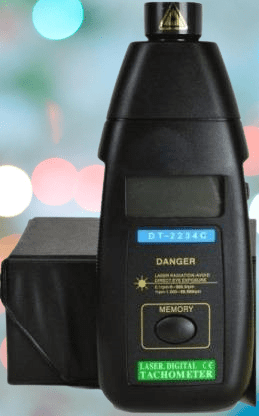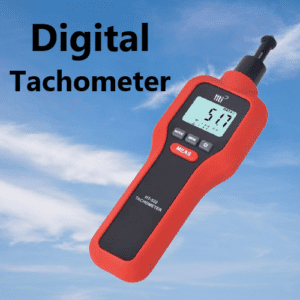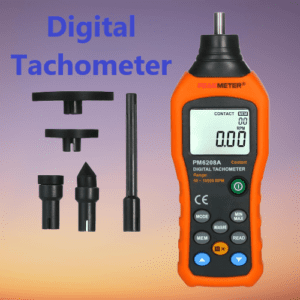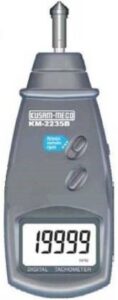The tachometer is an instrument used to measure and display the rotational speed of an engine’s crankshaft. It is a vital component of a vehicle’s dashboard, providing real-time information about the engine’s revolutions per minute (RPM). By monitoring the RPM, the tachometer enables drivers to gauge the engine’s performance, make informed decisions, and ensure optimal driving conditions.
The tachometer operates by detecting the electrical pulses generated by the engine’s ignition system or the rotation of a magnetic rotor. These pulses are converted into a corresponding RPM reading, which is then displayed on the tachometer dial or digital screen.
The primary purpose of the tachometer is to assist drivers in managing engine speed effectively. By observing the tachometer’s needle or digital display, drivers can determine the engine’s current RPM and adjust their driving accordingly. This is particularly crucial in manual transmission vehicles, where shifting gears at the right RPM range is essential for smooth acceleration and fuel efficiency.
what is a tachometer?
A tachometer is an instrument commonly found in vehicles that measure and displays the rotational speed of an engine’s crankshaft, usually expressed in revolutions per minute (RPM). It is a visual indicator, providing drivers with real-time information about the engine’s speed and performance. The tachometer monitoring the RPM helps drivers make informed decisions, such as when to shift gears, maintain fuel efficiency, and avoid overloading the engine. It acts as a crucial tool for understanding and optimizing engine behavior, ensuring a smoother and more efficient driving experience.

Digital tachometer
the digital tachometer stands as a testament to technological advancement and precision. With its sleek display and accurate readings, this instrument brings a new level of efficiency and convenience to the measurement of rotational speed.
Gone are the days of analog dials and mechanical components. The digital tachometer employs state-of-the-art electronic sensors and advanced microprocessors to provide drivers with real-time and highly accurate RPM readings. Its digital display, often in the form of a vibrant LCD or LED screen, presents a clear and easily readable representation of the engine’s revolutions per minute.

One of the standout features of the digital tachometer is its ability to offer additional information beyond basic RPM measurements. Many models come equipped with customizable settings that allow drivers to set warning thresholds for high or low RPM ranges. When the engine’s speed approaches or exceeds these thresholds, the digital tachometer provides visual or audible alerts, enabling proactive intervention and preventing potential damage.
Furthermore, the digital tachometer often incorporates other performance metrics alongside RPM. These may include indicators for engine temperature, battery voltage, and fuel consumption, providing a comprehensive snapshot of the engine’s overall health and efficiency. Such multifunctional capabilities empower drivers to have a comprehensive understanding of their vehicle’s performance in a single glance.
Another notable advantage of digital tachometers is their versatility and compatibility with various engine types. Whether it’s a gasoline engine, diesel engine, or even a hybrid powertrain, the digital tachometer can adapt and provide accurate readings, allowing drivers to monitor their engines across different vehicle models and configurations.
In terms of installation, digital tachometers offer straightforward integration into the vehicle’s electrical system. They often connect to the engine’s electronic control unit (ECU) or ignition system, utilizing electronic signals to capture precise RPM data. This streamlined integration ensures reliable and instantaneous readings, minimizing any lag or inaccuracies commonly associated with analog tachometers.
As technology continues to evolve, the digital tachometer remains at the forefront of innovation in engine monitoring. Its ability to deliver precise RPM measurements, customizable alerts, and comprehensive performance information makes it an indispensable tool for drivers seeking optimal control, efficiency, and engine longevity.
Tachometer working principle
The working principle of a techometer is based on detecting and measuring the electrical pulses or signals generated by the engine’s ignition system or the rotation of a magnetic rotor. These pulses are then converted into a corresponding numerical value, representing the engine’s rotational speed in revolutions per minute (RPM). The techometer utilizes sensors or transducers to capture these signals and transmit them to the instrument cluster.
In vehicles with an electronic ignition system, the techometer receives signals from the engine’s control unit or ignition coil. These signals are typically in the form of voltage pulses that occur with each ignition firing. The techometer interprets the frequency and duration of these pulses to determine the RPM of the engine.
In vehicles with a distributor ignition system, a magnetic rotor mounted on the engine’s rotating shaft generates pulses as it spins. The techometer incorporates a magnetic sensor or pickup located in close proximity to the rotor. As the rotor rotates, it induces a magnetic field fluctuation that is detected by the sensor, generating electrical signals proportional to the engine’s RPM.
Once the techometer receives the electrical signals, it processes and amplifies them using internal circuitry. The processed signals are then displayed on the techometer dial or digital screen, providing real-time RPM readings to the driver.
Tachometer is used to measure?
A tachometer is used to measure the rotational speed of an engine’s crankshaft. It provides a numerical value, typically in revolutions per minute (RPM), indicating how fast the engine is rotating. This measurement helps monitor the engine’s performance, optimize gear shifts, and ensure efficient operation of the vehicle.
Applications of tachometer
| Application | Description |
|---|---|
| Automotive | Monitoring engine RPM for optimal shifting and fuel efficiency. |
| Aviation | Measuring aircraft engine RPM for maintenance and performance evaluation. |
| Industrial Machinery | Monitoring and controlling rotational speed in machines such as motors, generators, and conveyor systems. |
| Power Generation | Monitoring and regulating rotational speed in power plant generators. |
| Marine | Monitoring and controlling boat engine RPM for navigation and efficiency. |
| Racing and Sports | Monitoring engine RPM in racing vehicles and sports equipment for performance optimization. |
| Manufacturing | Monitoring rotational speed in production lines and machinery for quality control and process optimization. |
| Research and Development | Measuring and analyzing rotational speed in experimental setups and prototypes. |
| Laboratory and Testing | Monitoring rotational speed in laboratory equipment and testing devices. |
| HVAC (Heating, Ventilation, and Air Conditioning) | Monitoring and controlling fan or blower motor speed in HVAC systems for proper air circulation. |
Frequently Asked Questions
What are the two main types of tachometers commonly used?
Answer: The two main types of techometers are analog techometers, which utilize a dial or needle display, and digital techometers, which display the RPM readings digitally.
How does an analog tachometer work?
Answer: Analog techometers typically use a mechanical or electrical system that translates the engine’s rotational speed into the movement of a needle on a dial, providing a visual representation of the RPM.
How does a digital tachometer work?
Answer: Digital techometers employ electronic sensors to detect the electrical pulses or signals generated by the engine’s ignition system or a rotating magnetic rotor. These signals are then processed and displayed digitally, providing precise RPM readings.
What is a redline on a tachometer?
Answer: The redline on a techometer indicates the maximum safe RPM range for the engine. Exceeding the redline for prolonged periods can lead to engine damage or failure.
What is the purpose of a shift light on a tachometer?
Answer: The shift light is a feature on some techometers that illuminates at a preset RPM value, signaling to the driver the optimal time to shift gears for maximum performance or fuel efficiency.
Can a tachometer be installed in any type of vehicle?
Answer: Yes, techometers can be installed in various types of vehicles, including cars, trucks, motorcycles, boats, and even some heavy machinery. However, the installation process may vary depending on the vehicle’s make and model.
Are tachometers compatible with both gasoline and diesel engines?
Answer: Yes, techometers are compatible with both gasoline and diesel engines. They can accurately measure and display the RPM of different engine types.
Can a tachometer be calibrated or adjusted?
Answer: Yes, some techometers offer calibration or adjustment options to ensure accurate readings. This may involve setting the correct number of engine cylinders or adjusting the scaling of the RPM display.
Can a tachometer detect engine malfunctions or irregularities?
Answer: Yes, unusual fluctuations or irregularities in the techometer reading can indicate potential engine malfunctions, such as misfires or mechanical issues, allowing drivers to take appropriate action.
Are there wireless or remote tachometers available?
Answer: Yes, wireless or remote techometers are available, particularly in applications where a physical connection to the engine is not feasible. These techometers utilize wireless technology to receive RPM data from a sensor placed near the engine.

